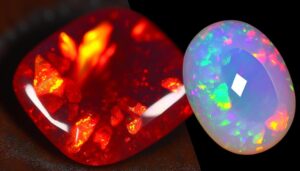Fire Opal vs Opal – 7 Key Differences You Need to Know
Both fire opals and common opals are hydrated amorphous forms of silica, but they exhibit unique characteristics. Fire opals, formed in volcanic regions, are renowned for their vibrant red, orange, and yellow hues due to iron oxide inclusions.
In contrast, common opals are famous for their play-of-color created by silica spheres that diffract light. Fire opals lack this play-of-color but their body color is intensely bright and alluring.
Generally sourced from Mexico, fire opals command higher prices due to their rarity. On the other hand, common opals are more widely found in Australia and Ethiopia.
If you're intrigued by these distinctions, there's more fascinating information ahead.
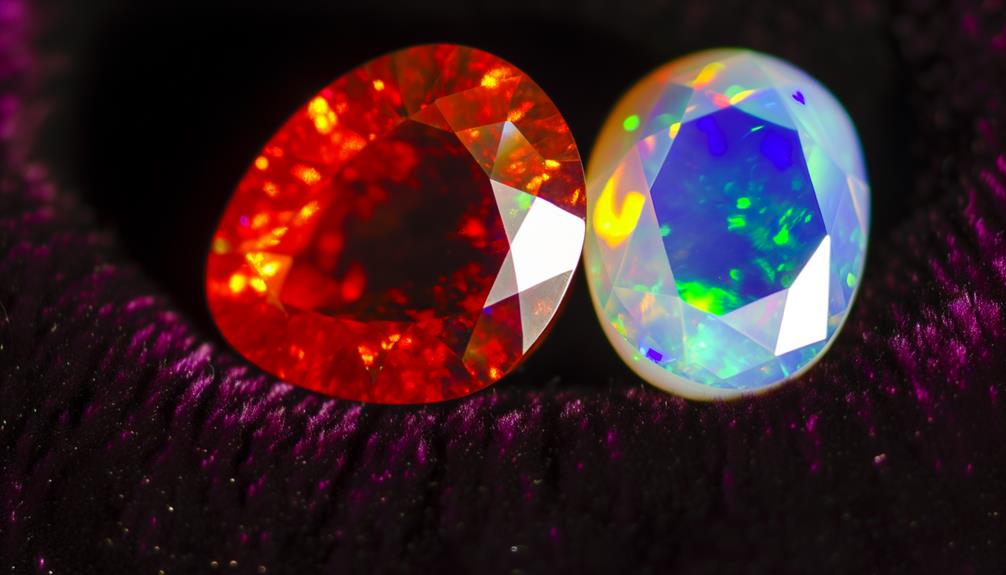
Key Takeaways
- Fire opals are renowned for their vibrant reds, oranges, and yellows, unlike common opals which display a wide range of colors and play-of-color.
- Fire opals primarily originate from volcanic regions in Mexico, while common opals are found in diverse locations including Australia, Ethiopia, and Brazil.
- The value of fire opals is higher due to their vivid body colors and rarity compared to more readily available common opals.
- Fire opals have a Mohs hardness of 5.5 to 6.5, slightly harder than common opals, which range from 5 to 6 in hardness.
- Fire opals are prized for their body color without a play-of-color, whereas common opals are celebrated for their unique play-of-color.
What Is an Opal?
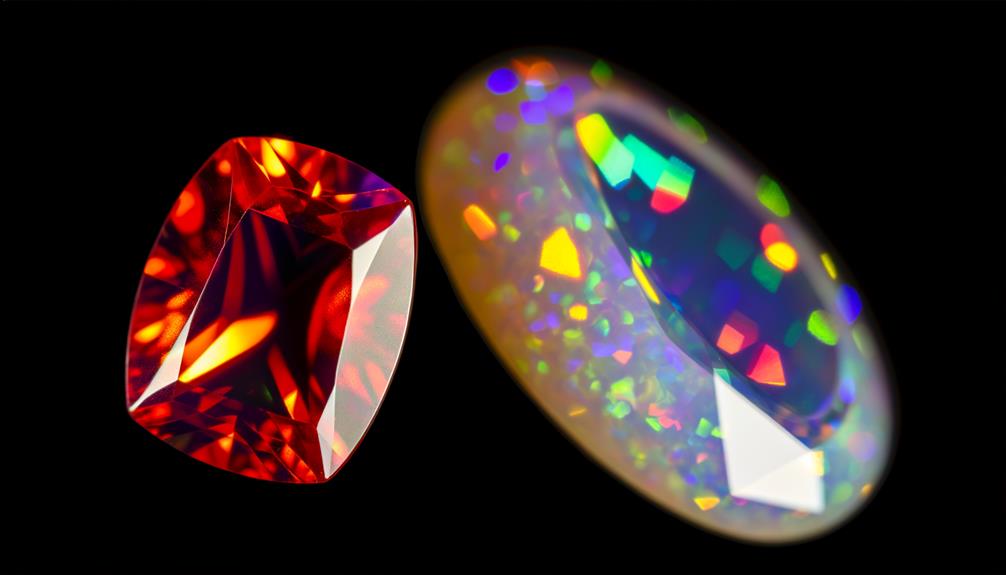
An opal is a hydrated amorphous form of silica, renowned for its unique play-of-color due to its internal structure. When you examine an opal, you'll notice it comprises submicroscopic silica spheres. These spheres form a grid-like pattern, diffracting light and creating that mesmerizing spectrum of colors.
Don't confuse this with simple color; it's a dynamic display that shifts as you move the gem. The water content in opals can range from 3% to 21%, affecting their stability and appearance. Opals are classified based on their body tone and transparency, with types like precious opal and common opal.
Understanding this structural composition is essential for appreciating the complexity and beauty of opals, setting the stage for distinguishing different varieties.
What Is a Fire Opal?
When you examine a fire opal, its unique color characteristics immediately stand out, typically showcasing vibrant reds, oranges, and yellows.
Most fire opals originate from volcanic regions in Mexico and can be found in other locations like Ethiopia and Australia.
Due to their striking appearance and limited availability, fire opals are highly valued and considered rare in the gemstone market.
Unique Color Characteristics
Fire opal captivates with its vivid, fiery hues ranging from red to orange, a result of the presence of iron oxide inclusions. Unlike common opals, which display a play of color due to diffracted light, fire opals are prized for their body color. The intensity of these hues is determined by the concentration of iron within the silica matrix.
| Color | Iron Oxide Concentration | Visual Impact |
|---|---|---|
| Deep Red | High | Intense, vibrant glow |
| Bright Orange | Moderate | Warm, radiant sheen |
| Yellow-Orange | Low | Soft, subtle warmth |
| Transparent | Trace | Clear, glass-like look |
This unique chromatic phenomenon sets fire opals apart, making them highly desirable for collectors and jewelers alike.
Origins and Locations
Beyond their striking colors, fire opals boast unique geological formations, primarily sourced from volcanic regions in Mexico. These gemstones form in rhyolitic lava flows where water interacts with silica-rich environments, creating opaline silica through a process called silica deposition. The high temperatures and pressures within volcanic activity catalyze the creation of these vivid stones.
Notably found in areas like Querétaro and Jalisco, Mexican fire opals are prized for their transparency and vibrant hues, ranging from yellow to deep red. Smaller deposits also exist in Brazil, Honduras, and the United States. Each location contributes subtle variations in color and clarity due to differing geological conditions.
Understanding these origins helps you appreciate why fire opals exhibit such alluring appearances and distinct characteristics.
Value and Rarity
A fire opal's value and rarity stem from its unique geological formation, vivid coloration, and transparency, making it a highly sought-after gemstone.
Formed in volcanic regions, fire opals develop within silica-rich lava flows, which imbue them with their characteristic fiery hues. The presence of iron oxide impurities results in the vibrant red, orange, and yellow colors that distinguish fire opals from common opals.
Transparency ranges from translucent to transparent, enhancing the gem's brilliance and desirability. The most valuable specimens exhibit intense color saturation and minimal inclusions.
Due to their specific formation conditions and the limited locations of these deposits, high-quality fire opals are relatively rare, further driving their market value and collector interest.
Formation Process
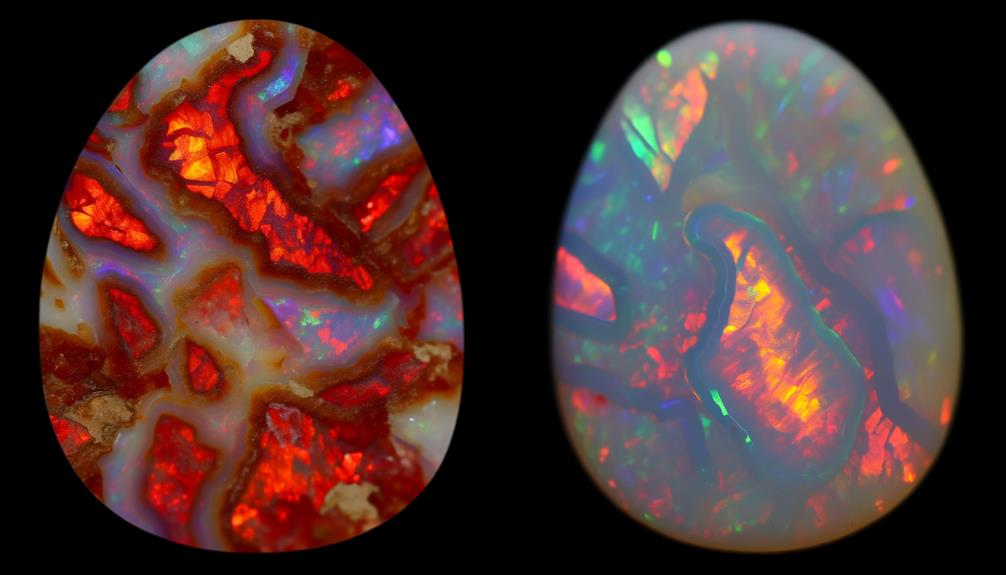
The formation process of opals involves the deposition of silica-rich solutions in rock cavities over millions of years. You'll find two types: precious opal and common opal, each forming under different conditions. The silica solution seeps into rock voids, slowly hardening. In fire opals, volcanic activity accelerates this deposition, creating their unique appearance.
Here's a comparison:
| Aspect | Fire Opal Formation | Common Opal Formation |
|---|---|---|
| Silica Source | Silica from volcanic activity | Silica from sedimentary processes |
| Water Content | Lower water content | Higher water content |
| Temperature | High temperatures | Moderate temperatures |
| Time Frame | Accelerated due to volcanic heat | Prolonged over millions of years |
Understanding these processes helps you appreciate the distinct characteristics each type of opal offers.
Color Variations
When comparing fire opals to common opals, you'll notice that the vivid color variations in fire opals result from their unique formation process involving volcanic activity. Fire opals typically exhibit warm hues, ranging from yellow to orange and red. These colors stem from iron oxide impurities introduced during their formation.
In contrast, common opals usually display a broader spectrum of colors, including whites, blues, and greens, due to the presence of water within their silica spheres. The distinction in coloration is primarily due to the differing geological conditions each opal type experiences.
Understanding these variations helps you appreciate the geological complexity and beauty inherent in each type of opal. This knowledge allows for more informed decisions when selecting or valuing opals.
Play-of-Color Explained
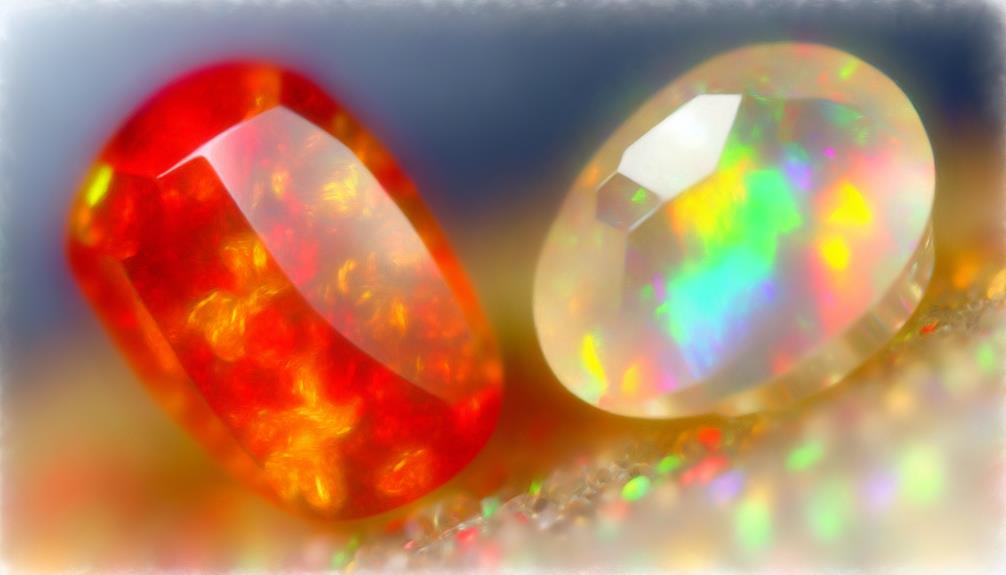
You'll need to understand the optical phenomenon behind play-of-color, which results from light diffraction within the microscopic silica spheres in opals. This effect produces vibrant, shifting colors across the spectrum, making each opal unique.
Comparing Fire Opal and common Opal, you'll notice significant variations in their color displays, influenced by their internal structure and composition.
Optical Phenomenon Basics
Understanding the play-of-color in opals involves examining how microscopic silica spheres diffract light into vibrant spectral hues. These silica spheres are arranged in a precise grid-like pattern, creating spaces where light waves interfere with each other, resulting in a dazzling array of colors. The size of the spheres and their arrangement determine the specific colors seen in the opal.
Here's how it works:
| Factor | Description | Impact on Color |
|---|---|---|
| Sphere Size | Smaller spheres diffract shorter wavelengths | Produces blues and violets |
| Sphere Arrangement | Regular, ordered patterns | Enhances color intensity |
| Light Interference | Constructive and destructive interference | Creates shifting colors |
Understanding this phenomenon helps you appreciate the unique beauty of opals and their intricate optical properties.
Color Spectrum Variations
Building on the basics of optical phenomena, the specific arrangement and size of silica spheres in opals result in a fascinating range of color spectrum variations known as the play-of-color.
When light enters an opal, it diffracts through these microscopic silica spheres. The size and pattern of these spheres determine the wavelength of light that's refracted, creating the vivid spectral colors you see. Smaller spheres produce blues and violets, while larger spheres result in reds and oranges.
In fire opals, however, the silica spheres aren't arranged in an orderly grid, which often minimizes the play-of-color, emphasizing the stone's fiery orange to red body color instead.
Understanding these variations enhances your appreciation for each opal's unique beauty.
Fire Opal Hues
Fire opal hues, ranging from vivid reds to warm yellows, are determined by the presence and concentration of iron oxide within the mineral.
When you examine a fire opal, you'll notice the intensity of its color directly correlates with the iron oxide content. Higher concentrations result in deeper reds, while lower amounts yield oranges and yellows.
This unique coloration process distinguishes fire opals from other opals, which primarily display play-of-color rather than body color.
Understanding that fire opals, unlike common opals, don't necessarily exhibit the characteristic rainbow-like play-of-color is crucial. Instead, their allure lies in their consistent, fiery hues, making them a sought-after gemstone for collectors and jewelers alike.
Geographic Origins
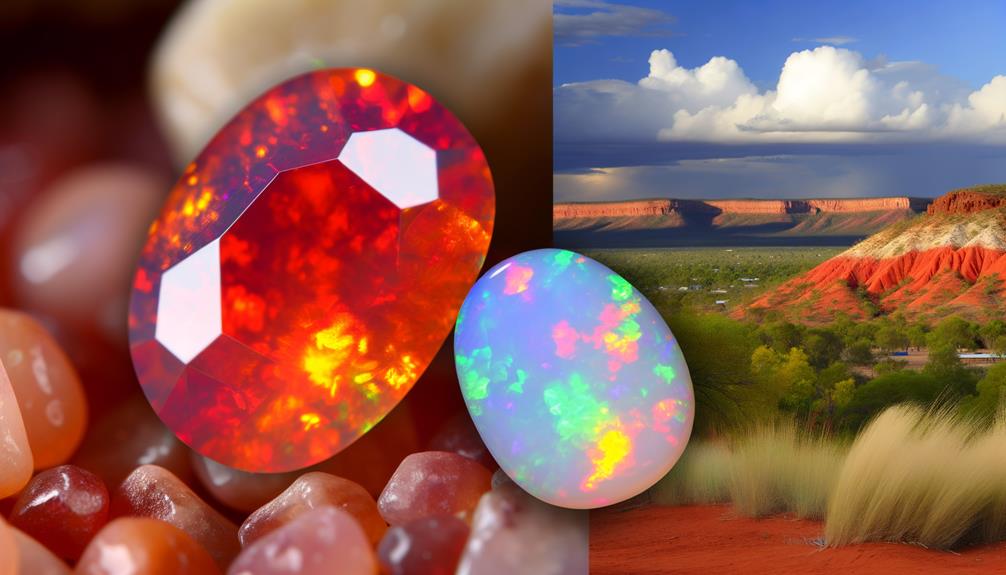
The geographic origins of fire opals are primarily concentrated in Mexico, with notable deposits also found in Brazil, Honduras, and the United States.
You'll find that Mexican fire opals are renowned for their vivid play-of-color and transparency.
Brazilian fire opals, on the other hand, are generally more translucent and exhibit a range of red and orange hues.
In Honduras, fire opals often occur within a basalt matrix, giving them a unique aesthetic.
Meanwhile, the United States, particularly Nevada, produces fire opals that are often found in rhyolite geodes.
Each location imparts distinctive characteristics due to varying geological conditions, such as mineral composition and formation processes, which affect the opal's color, clarity, and overall quality.
Value Comparison
When comparing fire opal and opal, you should consider their price differences and rarity factors.
Fire opals often command higher prices due to their vivid colors and relative scarcity.
In contrast, common opals are more readily available, leading to lower market values.
Price Differences
Evaluating the price differences between fire opals and common opals requires a detailed understanding of their unique characteristics, rarity, and market demand. Fire opals, with their vibrant, fiery hues, typically command higher prices due to their striking appearance and desirability in the gemstone market. Their transparency and vivid color saturation greatly influence their value.
In contrast, common opals, which range from translucent to opaque with a more subdued color palette, usually have a lower market value. However, the presence of play-of-color in common opals can increase their price. You must consider factors like cut, clarity, and carat weight for both types, as these also impact their market valuation.
Understanding these elements helps you make informed purchasing decisions.
Rarity Factors
Rarity heavily influences the value of fire opals and common opals, as gem enthusiasts seek unique specimens. Fire opals, known for their vibrant orange-red hues, are rarer than common opals. You'll find that their distinct coloration is due to trace amounts of iron within the silica structure, which is less frequently encountered in nature.
Conversely, common opals, despite their own unique range of colors and patterns, are more abundantly found. This abundance dilutes their market value compared to fire opals. The scarcity of premium-quality fire opals with high transparency and intense color saturation greatly elevates their worth. In contrast, common opals, although beautiful, typically don't command the same high prices due to their greater availability.
Durability and Hardness
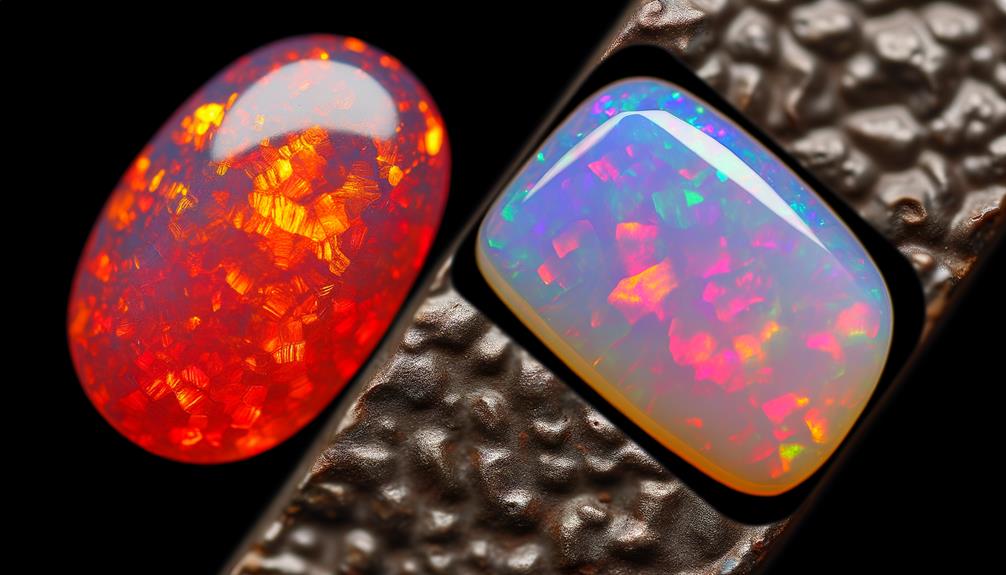
When it comes to durability and hardness, fire opals and common opals display distinct differences that greatly impact their suitability for different types of jewelry.
Fire opals typically have a Mohs hardness of 5.5 to 6.5, making them slightly harder than common opals, which range from 5 to 6. However, both types are relatively soft compared to gemstones like sapphires or diamonds.
Fire opals are more prone to cracking due to their lower water content, which makes them less stable under rapid temperature changes. Common opals, with higher water content, can also suffer from crazing—developing surface cracks over time.
To maximize their longevity, you should avoid exposing both fire opals and common opals to harsh chemicals and extreme temperatures.
Popular Uses
Fire opals and common opals each have their own unique appeal that influences their use in various types of jewelry and ornamental designs.
Fire opals, with their vibrant hues ranging from yellow to red, are often used in statement pieces like rings, pendants, and earrings to highlight their intense color. Their transparency and play of color make them ideal for cabochon cuts.
Common opals, known for their milky or translucent appearance, are frequently used in more subtle jewelry, such as beads or inlays, due to their softer, more understated appeal. Jewelers appreciate common opals for their versatility and the ability to complement various metals and gemstones.
Both types also find use in unique carvings and objets d'art, showcasing their diverse aesthetic properties.
Symbolism and Meanings
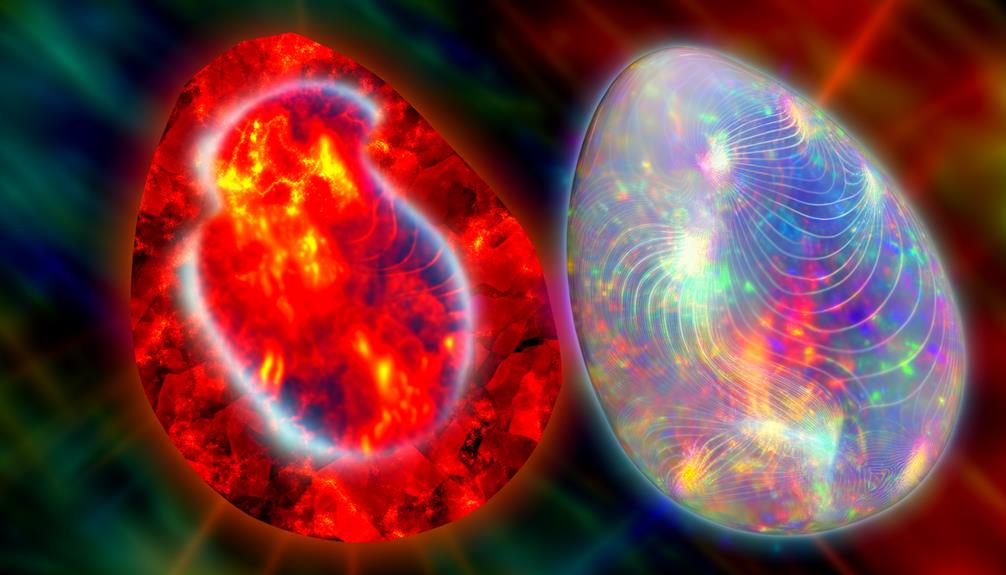
Both fire opals and common opals carry distinct symbolic meanings that have fascinated various cultures and gemstone enthusiasts throughout history. Fire opals, with their fiery hues, symbolize passion, energy, and creativity. They're often associated with emotional expressiveness and are thought to ignite inner strength and enhance personal power.
In contrast, common opals, known for their play-of-color, symbolize purity, hope, and amplification of positive emotions. They're believed to bring clarity, calm, and balance to the wearer. The spectral colors of common opals can stimulate creativity and promote a sense of optimism.
Understanding these symbolic meanings aids in appreciating the cultural and personal significance attributed to these gemstones, making your choice more meaningful and informed.
Care and Maintenance
Understanding the symbolic meanings behind fire opals and common opals enhances their value, but proper care and maintenance are essential to preserve their beauty and integrity. Both types of opals are relatively soft, rating around 5.5-6.5 on the Mohs scale. Store them separately to prevent scratches. Avoid drastic temperature changes, as opals contain water and can crack when dehydrated. Clean them gently using a soft, damp cloth; steer clear of harsh chemicals.
| Aspect | Fire Opal Care | Common Opal Care |
|---|---|---|
| Hardness | 5.5-6.5 Mohs | 5.5-6.5 Mohs |
| Storage | Keep apart to prevent scratches | Keep apart to prevent scratches |
| Temperature | Steer clear of extremes | Steer clear of extremes |
| Cleaning | Soft, damp cloth | Soft, damp cloth |
| Chemicals | Avoid | Avoid |
Proper maintenance safeguards lasting luster and brilliance.
Buying Tips
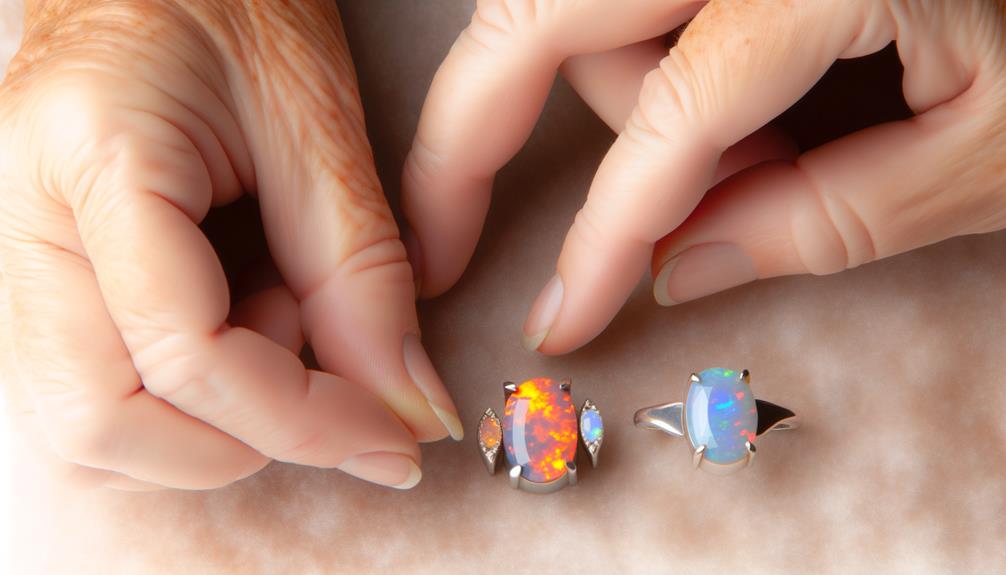
When purchasing fire opals or common opals, evaluate their transparency, color play, and overall quality to make sure you're making an informed investment.
For fire opals, look for a vibrant, fiery orange hue and a high degree of transparency, which indicates superior quality.
Common opals should exhibit strong play-of-color, with flashes of multiple colors as the stone moves. Examine the pattern of color play; a well-defined, broad pattern is preferable.
Inspect for any cracks or inclusions, as these can greatly reduce the gem's value.
Always request a certification from a reputable gemological institute to confirm authenticity and quality. By focusing on these factors, you'll secure you acquire a stunning opal that meets high standards.
Conclusion
So, when it comes to choosing between opal and fire opal, you now know the ins and outs. Each brings its unique allure and beauty, like comparing apples to oranges.
Understanding their formation, color variations, and play-of-color helps you make an informed decision. Whether you treasure symbolism or practical uses, you're equipped to care for and select the perfect gem.
Remember, knowledge is power—let it guide your next dazzling choice.

